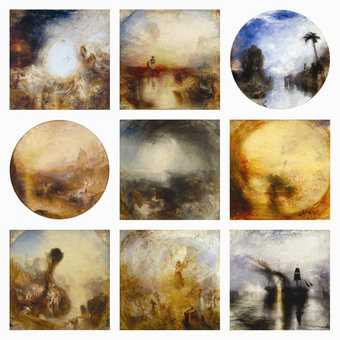
JMW Turner
9 finished square canvases, left to right
Undine Giving the Ring to Massaniello, Fisherman of Naples exh.1846 (Tate),
War. The Exile and the Rock Limpet exh.1842 (Tate)
Dawn of Christianity (Flight into Egypt) exh.1841 (Ulster Museum, Belfast)
Glaucus and Scylla – from Ovid’s Metamorphoses exh.1841 (Kimbell Art Museum, Fort Worth, USA)
Shade and Darkness – The Evening of the Deluge exh.1843 (Tate)
Light and Colour (Goethe’s Theory) – The Morning after the Deluge – Moses Writing the Book of Genesis exh.1843 (Tate)
Bacchus and Ariadne exh.1840 (Tate)
The Angel Standing in the Sun exh.1846 (Tate)
Peace – Burial at Sea exh.1842 (Tate)
Why did Turner start using square canvases?
I wish I knew! He wasn’t someone who ever wrote down why he was doing something, so you can only guess and deduce. I think there are probably various reasons. He had been making a number of book illustrations in vignette form, which are round or oval. That encouraged him to start thinking about how you could make a composition work within a curved shape. I think it was also a way in which he could compress the kind of swirling and vortex-type compositions that had been appearing in his paintings for a number of years, when he was painting things like rain, storms, waves or snow. Perhaps he thought that if they were compressed into a square shape, the spinning effect would be even more intense. The final reason might be that some of these pictures seem to be conceived as pairs. And if you have two square pictures they kind of equate to a landscape shape – or you could position them on either side of another picture.
Why are some of them framed as octagonal or circular shapes?
They are quite experimental and in some of them Turner had not quite decided when he started to paint them how they were going to end up. In some he has started to paint in the bottom corners but left the top onesunfinished, or has used the corners to test his colours.
What did people think of them at the time?
They didn’t go down very well with the critics – they didn’t understand them. They couldn’t get a handle on what he was trying to do. They were very angry about the colours and they couldn’t always understand the subject matter, which is quite strange in some ways. For example, it’s not immediately obvious what a picture of Napoleon in exile on St Helena has to do with the burial at sea of the painter David Wilkie. But there was a connection in Turner’s mind.
